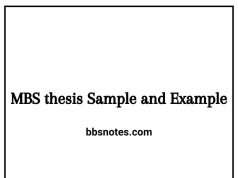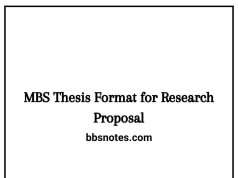We have the 4th year’s MBS thesis proposal sample pdf for download. If you are MBS 4th Semester student then it will be useful for you to prepare the final thesis proposal.
MBS thesis proposal sample pdf
Following is the MBS thesis proposal sample pdf.
Download the MBS thesis proposal sample pdf: CLICK HERE.
Table of Content
| Chapters | Chapters Name | Content of CHapters |
|---|---|---|
| 1 | Introduction | Background of the study. Statement of the problem. Objectives of the study. Significance of the study. Organization of the report. |
| 2 | Review of the literature | Conceptual review. Review of related studies. Concluding remarks. |
| 3 | Research methodology | Research design. Nature and sources of data. Population and sample. Sampling method. Data collection procedure. Data analysis tools. Models and variables. |
| Research Methodology |
Download the MBS thesis proposal sample pdf: CLICK HERE.
Some Extract of proposal.
Title: IMPACT OF CREDIT PERFORMANCE ON THE PROFITABILITY OF COMMERCIAL BANKS IN NEPAL
Chapter I: Introduction
Background of the study
Modern banking is an essential industry that operates within the periphery of the national as well as the international financial system. Financial systems allow funds to be allocated, invested, or moved between economic sectors. The health of the national as well as global economy largely depends on a highly regulated financial system. Banking is a vital section of such a system, Rose (2002) mentioned that it is one of the most heavily regulated businesses in the world. Therefore, many authors argue that no institution has shaped the economic development of the world more than the bank.
Statement of the problem
Various researchers have examined the impact of credit risk on bank return in varying dimensions with the sample from different country context. It is apparent that there are different measures of credit risk as well as banks’ return or profitability. Accordingly, the use of variables in the available works addressing credit risk and banks’ profitability is also not consistent. As a result, there is a scant of unanimity in findings.
Objectives of the study
The main objective of this study will be to investigate the impact of credit risk on the return of commercial banks in Nepal. Accordingly, the specific objectives will be as follows:
- I. To assess the credit risk exposure of the commercial banks operating in Nepal.
- II. To examine the status of profitability that commercial banks of Nepal are enjoying as a return.
- III. To analyze the impact of the credit-deposit ratio (CDR), non-performing loan (NPL), and capital adequacy ratio (CAR) on the profitability of the commercial banks of Nepal.
Read More: MBS Thesis Format for Research Proposal.
Significance of the study
Investigating the impact of credit risk management on the return of commercial banks operating in Nepal is the main purpose of this study. It is expected that this study will make a good contribution to the existing literature in academia. Accordingly, it will help to extend the current literature. In addition, this study is about the subject of financial matters and related to the applied field of the banking industry.
Organization of the study report
The fundamental purpose of the proposed study is to fulfill the partial requirements for the MBS Degree from Tribhuvan University. Therefore, the organization of the study report will be made accordingly. The first chapter will be the introduction of the study. It will contain background information, a statement of the problem, objectives, significance, limitations, and organization of the study.
Chapter II = Review of Literature
Conceptual review As stated by Rose (2002) credit risk is the danger of default by the borrower to whom a bank has extended credit. Bank capital and risk are intimately related each other. Therefore, the concepts of capital adequacy have been a subject of discussion among academia as well as professionals since many years. The main sources of credit risk include limited institutional capacity, inappropriate credit policies, volatile interest rates, poor management, inappropriate laws, low capital and liquidity levels, and directed lending, massive licensing of banks, poor credit assessment. Credit risk exposure means the total amount of credit extended to a borrower by a lender.
Review of related studies
There are plenty of studies available about the effect of different variables on the financial performance of commercial banks. Tarbert (2001) discussed in wider perspective on capital adequacy and the Basel Capital Accord and stated that adequate capital is a necessary condition for solvent banks and solvent banks are fundamental to the world economy. Adequate bank capital is thus essential for a sound economy. Bank capital is a vital component of economic stability; it has become a subject of concern for financial regulatory bodies around the world.
Concluding remarks
The aforesaid review represents only a preliminary survey of the relevant issue. On the basis of review, it can be concluded that still there are some unsolved research issues on the proposed subject. The purpose of this study is to see what new contribution can be made and receive some ideas, knowledge, and suggestions in relation to the impact of credit risk exposure and management practices on the performance of commercial banks.
Read More: MBS thesis Sample and Example.
CHAPTER III Research Methodology
Research Design
A research design is the logical and systematic planning that specifies the procedures for collecting and analyzing data and information. To attain the specified purpose of this study, descriptive research design will be considered an appropriate one. On the other hand, causal-comparative research method has also been followed. This study is intended to describe the phenomenon related to credit risk management and its effect on the return of commercial banks operating in Nepal. Accordingly, the overall study plan will be based on the quantitative approach of research.
Nature and Sources of Data
To fulfill the research objectives, most of the data will be collected from secondary sources. The required data, as demanded by the study, will be collected through the published annual reports of the sample banks. On the other hand, some supporting information has been collected from the website of Nepal Rastra Bank and other official websites.
Population and Sample
This study is based on the data of commercial banks in Nepal. Therefore, the total number of commercial banks is obviously the size of the population. As per the recent publication of Nepal Rastra Bank (NRB), there are 28 commercial banks operating in Nepal.
Sampling Method
The sampling method is the way the sample units are selected. So far the sampling method applied in this study is concerned; it has followed the non-probability sampling method. Accordingly, a purposive sampling design can be for the study. Specifically, the study will follow the judgmental sampling technique.
Data Collection
Procedure Data will be sourced from the annual reports of the banks in the sample. The data include time-series and cross-sectional data, i.e. pooled data set and estimated the effect of credit risk on the return of commercial banks using pooled data regression.
Data Analysis Tools
This study is quantitative in nature and analysis all the way through will be based on historical data. Therefore, the tools of the study are selected accordingly as demanded by the purpose of the study and data nature. For the analysis of data different financial ratios will be analyzed by means of descriptive statistics as well as inferential statistics.
Models and Variables
Models Basically, the variables under study are profitability and the Credit Performance (CP). As a proxy of profitability, Return on Assets (ROA) and Earning per Share (EPS) will be considere.
Dependent Variables
The important aspect of the study is to analyze an impact of credit risk on the return or profitability. Therefore, dependent variables are the proxies of profitability.
Independent Variables
To analyze an impact of credit risk on the return or profitability, as independent variables, Credit Deposit Ratio (CDR), Non Performing Loan (NPL), and Capital Adequacy Ratio (CAR),
Hence, you can get inspiration from the sample to write the proposal.
Other Important Links
a. MBS Thesis Format for Research Proposal.












